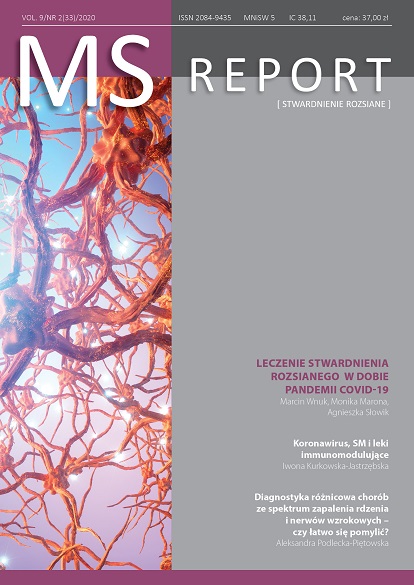Coronavirus, MS and immunomodulatory drugs Review article
Main Article Content
Abstract
SARS-CoV-2 coronavirus belongs to a family of viruses known to cause acute upper respiratory tract infections and having neurotropic properties. The distribution of SARS-CoV-2 is not limited to respiratory tract infection, but, as studies have shown, it reaches many organs, including the kidneys, intestine, heart and the brain. Patients with multiple sclerosis due to the burden of chronic disease and disability, and immunosuppressive treatment may be at greater risk of infection, although to date there is no evidence that they get COVID-19 more often or that the course of the disease is different for them than in the rest of the population. A serious problem for patients with MS and other diseases requiring prolonged immunosuppression is treatment during an epidemic, especially the initiation of therapy and the use of aggressive therapies with high immunosuppressive potential
Article Details
Copyright © by Medical Education. All rights reserved.
References
2. Huang C, Wang Y, Li X et al. Clinical features of patients infected with 2019 novel coronavirus in Wuhan, China. Lancet. 2020; 395(10223): 497-506. http://doi.org/10.1016/S0140-6736(20)30183-5.
3. Young BE, Ong SWX, Kalimuddin S et al. Epidemiologic features and clinical course of patients infected with SARS-CoV-2 in Singapore. JAMA. 2020; 323(15): 1488. http://doi.org/10.1001/jama.2020.3204.
4. Worldometers.info. Coronavirus.
5. Mehra MR, Desai SS, Ruschitzka F et al. Hydroxychloroquine or chloroquine with or without a macrolide for treatment of COVID-19: a multinational registry analysis. Lancet. Published online May 2020. http://doi.org/10.1016/S0140-6736(20)31180-6.
6. Andersen KG, Rambaut A, Lipkin WI et al. The proximal origin of SARS-CoV-2. Nat Med. 2020; 26(4): 450-2. http://doi.org/10.1038/s41591-020-0820-9.
7. Zhang L, Shen F, Chen F et al. Origin and evolution of the 2019 novel coronavirus. Clin Infect Dis. 2020; ciaa112. http://doi.org/10.1093/cid/ciaa112.
8. Wu D, Zou S, Bai T et al. Poultry farms as a source of avian influenza A (H7N9) virus reassortment and human infection. Sci Rep. 2015; 5(1): 7630. http://doi.org/10.1038/srep07630.
9. Ou X, Liu Y, Lei X et al. Characterization of spike glycoprotein of SARS-CoV-2 on virus entry and its immune cross-reactivity with SARS-CoV. Nat Commun. 2020; 11(1): 1620. http://doi.org/10.1038/s41467-020-15562-9.
10. Puelles VG, Lütgehetmann M, Lindenmeyer MT et al. Multiorgan and Renal Tropism of SARS-CoV-2. New England J Med. 2020: NEJMc2011400. http://doi.org/10.1056/NEJMc2011400.
11. Montalvan V, Lee J, Bueso T, de Toledo J et al. Neurological manifestations of COVID-19 and other coronavirus infections: A systematic review. Clin Neurol Neurosurg. 2020; 194: 105921. http://doi.org/10.1016/j.clineuro.2020.105921.
12. Bartosik-Psujek H, Adamczyk-SM, Kalinowska A et al. Stanowisko dot. leczenia SM w przypadku ryzyka zakażenia koronawirusem wywołującym COVID-19.
13. Giovannoni G, Hawkes C, Lechner-Scott J et al. The COVID-19 pandemic and the use of MS disease-modifying therapies. Mult Scler Relat Disord. 2020; 39: 102073. http://doi.org/10.1016/j.msard.2020.102073.
14. Persson R, Lee S, Ulcickas Yood M et al. Infections in patients diagnosed with multiple sclerosis: A multi-database study. Mult Scler Relat Disord. 2020; 41: 101982. http://doi.org/10.1016/j.msard.2020.101982.
15. Luna G, Alping P, Burman J et al. Infection risks among patients with multiple sclerosis treated with fingolimod, natalizumab, rituximab, and injectable therapies. JAMA Neurol. 2020; 77(2): 184. http://doi.org/10.1001/jamaneurol.2019.3365.
16. Wijnands JMA, Zhu F, Kingwell E et al. Disease-modifying drugs for multiple sclerosis and infection risk: a cohort study. J Neurol Neurosurg Psychiatry. 2018; 89(10): 1050-6. http://doi.org/10.1136/jnnp-2017-317493.
17. Epstein DJ, Dunn J, Deresinski S. Infectious complications of multiple sclerosis therapies: implications for screening, prophylaxis, and management. OFID. 2018; 5(8). http://doi.org/10.1093/ofid/ofy174.
18. Pei SN, Chen CH, Lee CM et al. Reactivation of hepatitis B virus following rituximab-based regimens: a serious complication in both HBsAg-positive and HBsAg-negative patients. Ann Hematol. 2010; 89(3): 255-62. http://doi.org/10.1007/s00277-009-0806-7.
19. Cohen JA, Coles AJ, Arnold DL et al. Alemtuzumab versus interferon beta 1a as first-line treatment for patients with relapsing-remitting multiple sclerosis: a randomised controlled phase 3 trial. Lancet. 2012; 380(9856): 1819-28. http://doi.org/10.1016/S0140-6736(12)61769-3.
20. Cohen JA, Barkhof F, Comi G et al. Oral fingolimod or intramuscular interferon for relapsing multiple sclerosis. NEJM. 2010; 362(5): 402-15. http://doi.org/10.1056/NEJMoa0907839.
21. Hauser SL, Bar-Or A, Comi G et al. Ocrelizumab versus interferon beta-1a in relapsing multiple sclerosis. NEJM. 2017; 376(3): 221-34. http://doi.org/10.1056/NEJMoa1601277.
22. Giovannoni G, Comi G, Cook S et al. A Placebo-Controlled Trial of Oral Cladribine for Relapsing Multiple Sclerosis. NEJM. 2010; 362(5): 416-26. http://doi.org/10.1056/NEJMoa0902533.
23. Murray RS, Brown B, Brain D et al. Detection of coronavirus RNA and antigen in multiple sclerosis brain. Ann Neurol. 1992; 31(5): 525-33. http://doi.org/10.1002/ana.410310511.
24. Murray RS, Cai G-Y, Hoel K et al. Coronavirus infects and causes demyelination in primate central nervous system. Virology. 1992; 188(1): 274-84. http://doi.org/10.1016/0042-6822(92)90757-G .
25. Arbour N, Day R, Newcombe J et al. Neuroinvasion by human respiratory coronaviruses. J Virol. 2000; 74(19): 8913-21. http://doi.org/10.1128/JVI.74.19.8913-8921.2000.
26. Stewart JN, Mounir S, Talbot PJ. Human coronavirus gene expression in the brains of multiple sclerosis patients. Virology. 1992; 191(1): 502-5. http://doi.org/10.1016/0042-6822(92)90220-J .
27. Templeton SP, Perlman S. Pathogenesis of acute and chronic central nervous system infection with variants of mouse hepatitis virus, strain JHM. Immunol Res. 2007; 39(1-3): 160-72. http://doi.org/10.1007/s12026-007-0079-y.
28. de Santis G. SARS-CoV-2: A new virus but a familiar inflammation brain pattern. Brain Behav Immun. Published online April 2020. http://doi.org/10.1016/j.bbi.2020.04.066.
29. Sormani MP. An Italian programme for COVID-19 infection in multiple sclerosis. Lancet Neurology. 2020; 19(6): 481-2. http://doi.org/10.1016/S1474- 4422(20)30147-2.
30. Hung IFN, Lung KC, Tso EYK et al. Triple combination of interferon beta-1b, lopinavir–ritonavir, and ribavirin in the treatment of patients admitted to hospital with COVID-19: an open-label, randomised, phase 2 trial. Lancet. 2020; 395(10238): 1695-704. http://doi.org/10.1016/S0140-6736(20)31042-4.
31. Foerch C, Friedauer L, Bauer B et al. Severe COVID-19 infection in a patient with multiple sclerosis treated with fingolimod. Mult Scler Relat Disord. 2020; 42: 102-80. http://doi.org/10.1016/j.msard.2020.102180.
32. Novi G, Mikulska M, Briano F et al. COVID-19 in a MS patient treated with ocrelizumab: does immunosuppression have a protective role? Mult Scler Relat Disord. 2020; 42(102120): 102120. http://doi.org/10.1016/j.msard.2020.102120.

